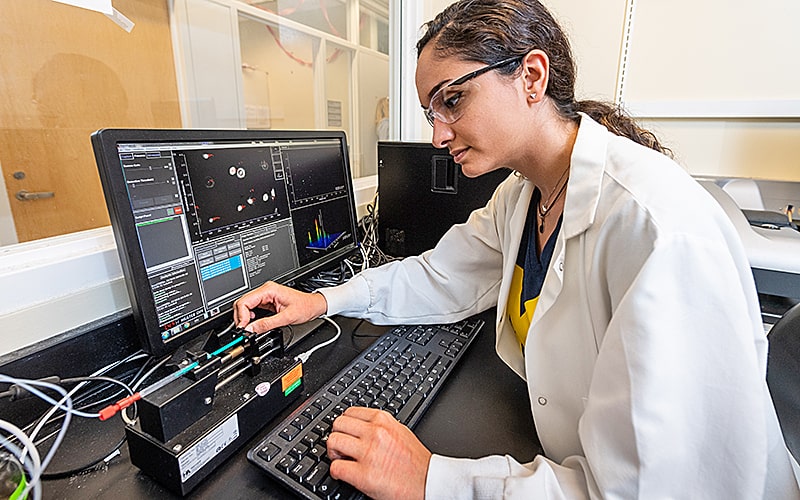
Materials

New catalysts for biomass conversion, new sorbents for CO2 capture or H2 storage, self assembly of nanoscale building blocks to make new materials, new biomaterials for medical devices, new electrode materials for batteries and new membranes are among the topics being explored in the Chemical Engineering Department. We develop and employ both computational and experimental approaches.
Brendon Baker
The Baker lab studies how structure and mechanics of the cellular microenvironment guide fundamental cell processes such as migration, proliferation, and extracellular matrix synthesis. To do so, we use microfabrication technologies to create synthetic biomaterials that mimic the 3D, fibrous nature of stromal or interstitial tissues. Combined with molecular tools, live imaging, microfabrication/fluidic techniques, and multi-scale mechanical characterization, these materials allow us to model, study, and control the interactions between cells and their surroundings. Ultimately, we aim to 1) shed insight into extracellular matrix-mediated diseases such as cancer and fibrosis and 2) use material cues to direct cell function for tissue engineering and regenerative medicine applications.
Sharon Glotzer
Professor Sharon Glotzer and her research group use computer simulation to discover the fundamental principles of how nanoscale building blocks can self-assemble and how to guide that process to engineer new materials. Her team develops the theory and molecular simulation tools to understand self-assembling, self-sensing and self-regulating materials.
Bryan Goldsmith
Professor Goldsmith’s group uses molecular simulation and data analytics tools to understand various materials for a variety of sustainable applications, especially chemical production and energy generation. Recent topics of focus include: amorphous materials and complex metal oxides for use as catalyst components; crystal structure and property prediction of oxide materials using data analytics tools (e.g., compressed sensing and data mining); and entropy stabilized materials.
Xiwen Gong
The Gong research group focuses on the innovative design of hybrid semiconducting materials with superior and unprecedented properties.Our goal is to widen the property space of soft semiconductors for next generation bioelectronics.
Jovan Kamcev
Professor Kamcev and his research group develop new polymeric materials (membranes, adsorbents, mixed-matrix membranes) for water treatment and energy storage/generation applications.
Nicholas Kotov
Professor Nicholas Kotov and his research group study the self-organization of nanoparticles into more complex structures, layer-by-layer assembly and 3D scaffolds. Nanomaterials and those assembled in thin layers are promising for electronic and medical devices, while 3D scaffolds create microenvironments for cell cultures that resemble their natural conditions.
Mark Kushner
Current projects of Professor Mark Kushner and his team include plasma fabrication of advanced materials for nano-electronics, plasmas in liquids and plasma treatment of porous polymeric membranes.
Computational Plasma Science and Engineering Group
Joerg Lahann
Professor Joerg Lahann’s research interest is focused on the development of active, multi-functional bio-interfaces, which are applicable to a range of biomedical applications. His group’s recent advances in the molecular design of active nanostructures include the introduction of reactive coatings, reversibly switching surfaces, and anisotropic nanoparticles that support the vision of smart interfaces and act as templates in time-controlled surface interactions.
Andrej Lenert
Professor Andrej Lenert and his team study and develop nanoporous composites with tailored transport properties and control over the spectral content of energy flow.
Rebecca Lindsey
Professor Lindsey’s group develops advanced simulation tools to establish a fundamental understanding of how chemistry mediates material behavior in extreme temperature/pressure environments and in complex systems. Her group leverages this new knowledge for material discovery and design, and to inform development of next-generation materials synthesis and manufacturing methods. Her group specializes in condensed phase simulation spanning quantum mechanical to coarse-grained scales, and artificial intelligence (e.g., machine learning) for efficient simulation and data-driven prediction.
Albert Liu
Arming nano-electronics with mobility extends artificial systems into traditionally inaccessible environments. Quantum-confined nanoparticles (0D), carbon nanotubes (1D), graphene (2D) and other crystalline materials with well-defined lattice structures can be incorporated into polymer microparticles (i.e., colloidal electronics), granting them unique electronic functions. The Liu laboratory seeks to advance device capabilities for individual colloidal electronic particles, and explores higher-order assemblies of these building-blocks into hierarchical colloidal electronic matter. This research program, positioned at the intersection between materials design, chemical catalysis, and electronic device fabrication, aims to address one central challenge: Can we build materials the way nature builds us?
Laboratory of Emergent and Galvanically Orchestrated Systems (LEGOS)
claudia loebel
The Loebel lab develops soft biomaterials – with a specific interest in polymeric hydrogels – to recreate certain aspects of the extracellular matrix (ECM). Through the design of hydrogel platforms that are mechanically and structurally dynamic her group aims to recreate complex cell-ECM interactions and model tissue morphogenesis. The ultimate goal is to use these materials to develop and translate more effective therapeutic treatments for diseases such as fibrotic, inflammatory and congenital disorders.
ERANDA NIKOLLA
Professor Nikolla and her group focus on the design of catalytic materials (nonstoichiometric mixed metal oxides, metal and metal alloys) for energy conversion and storage technologies, including low temperature fuel cells and electrolyzers, solid oxide fuel cells and electrolysis cells, and metal air batteries.
Jouha Min
Deepak Nagrath
Nagrath Lab (Systems Biology of Human Diseases)
Johannes Schwank
Professor Johannes Schwank and his research group are involved in developing the next generation of energy storage materials for batteries as part of a DoE funded Energy Innovation Hub.
Ashwin Shahani
Professor Shahani and his team specialize in the application of nondestructive and in situ characterization techniques in an effort to understand the emergence of nanoscale patterns in nature. His group has developed novel approaches for integrated imaging across the relevant length- and time-scales.
Lonnie Shea
Professor Lonnie Shea’s laboratory is developing and using biomaterials as scaffolds for tissue growth with applications in regenerative medicine, cancer diagnostics, and immune-engineering.
Max Shtein
The research group led by Professor Max Shtein is interested in organic and hybrid organic/inorganic materials and devices, with applications in solid-state energy conversion and sensing. Current projects include plasmon-enhanced hybrid organic/inorganic solar cells, nanoscale light sources and photodetectors for high resolution microscopy, organic solar cells and LEDs on fibers, woven thermoelectric devices, and organic vapor jet printing.
Michael Solomon
The research of Professor Michael Solomon and his group investigate complex fluids—soft materials with properties intermediate between fluids and solids. Solomon’s current interests include nanocolloidal assembly, colloidal gelation and the biomechanics of bacterial biofilms. Applications of interest include creating new optical materials, sensors, biomedical devices and procedures, as well as materials for energy management.
Anish Tuteja
Professor Anish Tuteja and his group use polymers to address key challenges in the areas of renewable energy and environmental science. The team develops super oil-repellent surfaces, super water-repellent surfaces, ice-repellent surfaces, membranes, and polymer nanocomposites. Applications include the separation of oil and water and energy-conversion materials for solar cells.